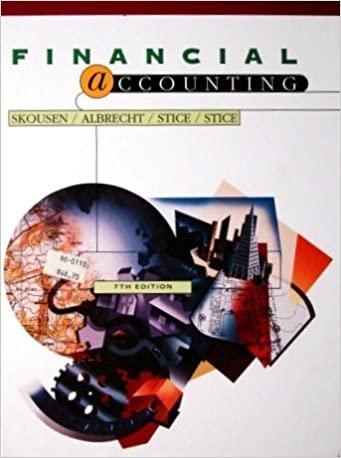Question
The beginning inventory at Midnight Supplies and data on purchases and sales for a three month period ending March 31 are as follows: Date Transaction
The beginning inventory at Midnight Supplies and data on purchases and sales for a three month period ending March 31 are as follows:
| Date | Transaction | Number of Units | Per Unit | Total | |
| Jan. | 1 | Inventory | 2,600 | $58.00 | $150,800 |
| 10 | Purchase | 7,200 | 66.00 | 475,200 | |
| 28 | Sale | 3,950 | 116.00 | 458,200 | |
| 30 | Sale | 1,300 | 116.00 | 150,800 | |
| Feb. | 5 | Sale | 500 | 116.00 | 58,000 |
| 10 | Purchase | 17,500 | 68.00 | 1,190,000 | |
| 16 | Sale | 9,200 | 121.00 | 1,113,200 | |
| 28 | Sale | 8,000 | 121.00 | 968,000 | |
| Mar. | 5 | Purchase | 14,400 | 69.60 | 1,002,240 |
| 14 | Sale | 10,100 | 121.00 | 1,222,100 | |
| 25 | Purchase | 3,300 | 70.00 | 231,000 | |
| 30 | Sale | 7,900 | 121.00 | 955,900 | |
| Instructions | |
| 1. | Record the inventory, purchases, and cost of goods sold data in a perpetual inventory record similar to the one illustrated in Exhibit 3 , using the first-in, first-out method. |
| 2. | Determine the total sales and the total cost of goods sold for the period. Journalize the entries in the sales and cost of goods sold accounts. Assume that all sales were on account and date your journal entry March 31. Refer to the Chart of Accounts for exact wording of account titles. |
| 3. | Determine the gross profit from sales for the period. |
| 4. | Determine the ending inventory cost as of March 31. |
| 5. | Based upon the preceding data, would you expect the ending inventory using the last-in, first-out method to be higher or lower? |
| CHART OF ACCOUNTS | |||||||||||||||||||||||||||||||||||||||||||||||||||||||||||||||||||||||||||||||||||||||||||||
| Midnight Supplies | |||||||||||||||||||||||||||||||||||||||||||||||||||||||||||||||||||||||||||||||||||||||||||||
| General Ledger | |||||||||||||||||||||||||||||||||||||||||||||||||||||||||||||||||||||||||||||||||||||||||||||
|
| ||||||||||||||||||||||||||||||||||||||||||||||||||||||||||||||||||||||||||||||||||||||||||||
FIFO 1. Record the inventory, purchases, and cost of goods sold data in a perpetual inventory record similar to the one illustrated in
Exhibit 3
, using the first-in, first-out method. Under FIFO, if units are in inventory at two different costs, enter the units with the LOWER unit cost first in the Cost of Goods Sold Unit Cost column and in the Inventory Unit Cost column.
| Date | Purchases | Cost of Goods Sold | Inventory | ||||||
| Date | Quantity | Unit Cost | Total Cost | Quantity | Unit Cost | Total Cost | Quantity | Unit Cost | Total Cost |
| Jan. 1 | |||||||||
| 10 | |||||||||
| 10 | |||||||||
| 28 | |||||||||
| 28 | |||||||||
| 30 | |||||||||
| Feb. 5 | |||||||||
| 10 | |||||||||
| 10 | |||||||||
| 16 | |||||||||
| 16 | |||||||||
| 28 | |||||||||
| Mar. 5 | |||||||||
| 5 | |||||||||
| 14 | |||||||||
| 14 | |||||||||
| 25 | |||||||||
| 25 | |||||||||
| 30 | |||||||||
| 30 | |||||||||
| 31 | Balances | ||||||||
2. Determine the total sales and the total cost of goods sold for the period. Journalize the entries in the sales and cost of goods sold accounts. Assume that all sales were on account and date your journal entry March 31. Refer to the Chart of Accounts for exact wording of account titles.
PAGE 10
JOURNAL
ACCOUNTING EQUATION
| DATE | DESCRIPTION | POST. REF. | DEBIT | CREDIT | ASSETS | LIABILITIES | EQUITY | |
|---|---|---|---|---|---|---|---|---|
| 1 |
|
|
|
|
|
|
|
|
| 2 |
|
|
|
|
|
|
|
|
| 3 |
|
|
|
|
|
|
|
|
| 4 |
|
|
|
|
|
|
|
|
3. Determine the gross profit from sales for the period.
4. Determine the ending inventory cost as of March 31.
5. Based upon the preceding data, would you expect the ending inventory using the last-in, first-out method to be higher or lower?
A. Higher
B. Lower
Step by Step Solution
There are 3 Steps involved in it
Step: 1

Get Instant Access to Expert-Tailored Solutions
See step-by-step solutions with expert insights and AI powered tools for academic success
Step: 2

Step: 3

Ace Your Homework with AI
Get the answers you need in no time with our AI-driven, step-by-step assistance
Get Started


